Situational Awareness
and the Napoleonic Commander
Battlefield Process
by David Commerford, UK
| |
Keegan, as Brent Nosworthy says, in his Battle Tactics of Napoleon and His Enemies, “democratised the scope of what should be considered relevant and thus worthy of study” In doing so, he opened the door for the examination of the “how and why” of the battlefield. Even though Waterloo only provided part of the books content and Command, as such, was not examined in specific detail, it set in motion the style of work that Nosworthy and more recently Rory Muir (Tactics and the Experience of Battle in the Age of Napoleon) have given us.
In terms of a truer examination of how Napoleonic combat was conducted, The Face of Battle introduced the world of history to the experimental and psychological arena.
This then brings me to Situational Awareness (SA).
Essentially, SA is a method of examining, or describing, the interrelationship between an individual, the task, or range of tasks, they are required to perform and the environment they are required to perform in. It has its roots in a range of diverse activity such as, aircrew safety, and operations, or the conduct of military command and control systems. There are a lot of Internet sites available that can give you a lead into the world of SA. Many are aviation related, although military ones do exist. I have chosen, for this article, to use headings from the US Navy, Aviation Schools Command, Web site, which gives a clear layout of the basics of SA and the relationship to decision making.
Though like a lot of modern concepts, SA is alive with buzz words and dedicated parlance. It describes principals of interaction and thought process, that, in real terms, go back far beyond even the Napoleonic period. So, what’s the point of all this you may wonder.
Well yes, on that last one, actually, he did. More to the point, if he was only getting information from three directions at the same time he was damn lucky!
It is worth noting that SA is a subjective state, dependant on an individuals situation. The factors assessed by a front-line Brigade commander will not be entirely the same as a Corps commander charged with the co-ordination of a dozen Brigades.
In addition, the manner in which some of its key elements are handled will vary from individual to individual, even if those individuals are in an identical situation. Factors such as training and experience levels, for example, will alter how individuals assess what they perceive. However, there are common values, or parameters, that if we chose to examine them, can help us towards an understanding of what our “typical” Napoleonic Commander had to contend with.
SA is also a valuable tool in helping us construct, or examine, the “realism” of wargames rules. In that it describes the factors that effect human actions in a manner which enables us to see which have, or have not, been included in the Command and Control systems of the game mechanics.
Our imaginary general will through deliberate, or subconscious processes, be asking himself a series of questions.
In answering these questions the commander is, in fact assessing and updating his own Situational Awareness:
“Situational Awareness refers to the degree of accuracy by which ones perception of his current environment mirrors reality.”
“Effective decision making refers to the ability to use logical and sound judgement to make decisions based on available information.”
US Navy, Aviation Schools Command
To begin with, Commanders needed “a view” in both senses of the word. That is a physical, as well as a mental picture, of what was happening and what they wanted to happen. In this era of limited communication the Commander’s personal observation was both vital and difficult to obtain. Smoke, troops and inconvenient aspects of the planet’s surface, conspired to prevent it. The acquisition of a good observation point and the time taken to inspect the progress of battle, taxed Generals at all levels, throughout the period.
As a result, there was a constant trade off, between time taken to obtain a worthwhile observation and the value of the resulting information that could be used to update the mental picture. Being in the right place at the right time to make a key observation could mean the difference between success and failure.
Readers will no doubt be familiar with Wellington’s observation of the separation of Marmont’s Divisions at Salamanca, for example. What might of happened, if he as commander in chief, had decided to allocate himself some other task during that crucial hour?
Incoming Information
“The most difficult thing is to discover the enemy’s plans and to detect the truth in all the reports one receives; the remainder only requires common sense.” --Napoleon, quoted in, Gourguard’s, Journal de Sainte-Helene
Commanders were required to constantly process various types of incoming information. Visual, written, spoken and audio information had to be constantly absorbed, sifted and compared with what the commander intended or observed. The dust cloud from a moving formation, written or spoken transmission of orders, or information up dates received from subordinates, a sudden crescendo of gunfire. All served to make up the commanders image of the action as it unfolded and had to be assimilated in terms of what was known or thought to be known. The weight given to pieces of information, in relation to each other and tactical circumstances, was a crucial part of the decision process.
These are the factors by which a commander would measure events. An experienced commander would be able to gauge the probable time an event or sequence of events would take under various conditions. This was a particularly important skill in an age where communication was slow and uncertain and visibility often non-existent. As with many military or other virtues it was not equally given. In fact it was one of the major areas that separated a good commander from a poor one.
In addition, the skill lay in the ability to determine if the expectations were valid, on each and every occasion. That is to say, the commander not only had to evaluate whether his expectations were sound in terms previous experience (assuming that there were such) but also in terms of events actually taking place.
As these were inevitably modified by the presenting realities, they had to be rapidly compared with, what had happened in the past. A separate evaluation of the risk needed to be made on each occasion, or disaster could result.
This may sound a particularly fine statement of the obvious but in the heat of the moment it took a cool and professional head to make such decisions and not act on an assumption.
Incoming Information versus Expectations
Even the most experienced commanders could believe what they wanted to believe, rather than what was happening. At Waterloo, Ney chose to believe the Allied centre was collapsing rather than just pulling back. Without taking time for verification, he launched the ill fated cavalry attacks against what proved to be formed infantry squares.
It is also worth mentioning that “awareness” is only part of the trick. Sifting information in a proper manner to gain an “understanding” is something else. So it was in this instance. Ney was aware that there were retrograde movements in the Allied, line what he failed to understand, was the reason why!
Of course there were other factors at work. Ney would have been aware of his part in the overall strategy by which Napoleon had intended to encourage Wellington to weaken the centre. As well as the pounding the opposing unit’s had already taken. Also he saw, or was informed of, quite sizeable retrograde movement in the Allied line. So in this instance it could be argued that all available information supported the expectation that the punishment inflicted, had achieved expectations and he acted accordingly. Finally, it must also be remembered that in working terms, Ney and his staff were virtual strangers, due to his late appointment, which would scarcely enhance SA.
There again, how many of you honestly believe Davout would have done the same thing. SA as we have already noted is indeed subjective!
The other side of the SA coin is how commanders, become confused by conditions, events or their own perceptions. Or, if you prefer, Situationaly Unaware.
Many of these features we have already touched upon in the Waterloo example. Misinformation, poor communication, probable lack of visibility (the battle had been underway for hours and many respondents in the Sibourne letters tell of how poor visibility had become throughout the field) all these contributed to a poor level of SA and a poor decision.
Fatigue / Stress
We are all familiar, with how work performance, or alertness while driving, is effected by fatigue. Thankfully, few of us have, or will ever be likely to be, responsible for the lives of thousands under similar circumstances. However, for our Napoleonic commander operating in the freezing cold, driving rain, fog or blistering heat, while often suffering sleep deprivation over an extended period, was common place. Added to this was the small matter of stress from extreme levels of personal danger, wounds, and responsibility for rapid decisions.
Try playing your next wargame, while wearing a jousting helm, using only written orders to the other players, who move their units as they interpret the situation. At the same time have one of your mates impersonate the Marine Gunnery Sargent, from Full Metal Jacket in your ear, as another counts down the time you have left to issue the next order, before he pours hot porridge in your underwear and you might get the idea!
In fairness to the aforementioned Prince de la Moskowa’s Waterloo performance, he may have suffered particularly in this regard (well all right, not the porridge part). He had little sleep prior to the events and could well have been suffering from what now be regarded as residual combat fatigue, from the 1812 campaign. Having literally walked out of Russia, with the remnants of the rearguard. One could also speculate that he might have been trying to redress the balance for having screwed up at Quatre Bras. In more clinical terms, would this desire to over achieve, in itself, not be stress by an other name?
Task Overload
If the force under command was placed into a situation that resulted in a series of rapidly changing circumstances, such as being caught during deployment or being taken by surprise for what ever reason, the ability to make clear and correct decisions would go straight out of the window. In the face of an inability to process information quickly enough to organise an effective response, a Brigade or Division could crumble in minutes.
Consider the chain of events that wrecked D’Erlon’s Corps at Waterloo. First we have Donzelot, famously in the wrong formation. The Division halts below the crest, unaware of Picton’s deployment, to correct the mistake. Kempt’s Brigade pop up from the sunken road and hedges to their front, like a pantomime genie through a stage trap and wham! Meanwhile, Marcognet who’s Division has now caught up with the advance, sweeps over the crest to only to find Pack’s Brigade deployed and waiting, wham again! Finally, as Donzelot’s men reel back, they along with Marcognet’s units, who are still trying to get some sort of order restored, make the acquaintance of the Union Brigade, oh dear!
Task Underload
Possibly not the highest likely hood on the Napoleonic battlefield, as things did tend to get bit busy. However, as people were outflanked and attacked from angles they did not allow for, on some occasions this could be regarded as the result of a lack of SA, caused by the expectation of not being heavily involved in the action in either the short or long term. Along with a failure to account for eventualities by observational arrangements and alternative plans.
Group Mindset
Tricky one this. I would suggest however that it could apply. In terms of an example of an attitude that would engender a level of overconfidence, such as appeared in the Prussian high command, during the 1806 campaign. It could also describe the ridged adherence to established tactics or SOP and poor staff work that permeated Allied armies in the pre 1809 period. This lack of flexibility would have greatly inhibited their commanders ability to match their French counter parts level of SA, at key points.
“Press on Regardless” Philosophy
There are so many possible instances of this attitude it is virtually impossible to chose one!
So at the risk of offending as many people as possible I’ll go for the man himself.
Napoleon must have fallen foul of this SA detractor almost as many times as he successfully applied the positive ones. Ligny, Borodino, Aspern/Essling take your pick.
In my view any where that the determination to place troops in the path of a hammering, regardless of being on the offensive or defensive, when other options were available, illustrates a wonderful disregard of SA, if not tactical alternatives.
To this list we might also add the trio of Generals Olsufiev, Sacken and Yorck with regard to the battles of Champaubert, Montmiral and Chateau-Thierry in 1814. Though in their case it’s hard to judge if the lack of SA was more in the Strategic than the Tactical, in which case one must blame Blucher!
Degraded Operating Conditions
This area was paramount in effecting SA in the Napoleonic period, along with other restrictions to line of sight based information, caused by having nothing available from an altitude above the highest available physical vantage point.
It is interesting to note that even as we move into the 21st Century the British Army is about to commission a mobile smoke generation system, which trials have shown, can smoke out sizeable areas of countryside in no time, flat. So smoke obscuration still has its place on the battlefield. (Even if it does require powdered graphite injection to blank out thermal imaging)
Our Napoleonic forefathers had no need of such additional refinement, their weapon systems provided all the smoke they ever needed! To this we can all think of additional problems such as the snow at Eylau, the driving rain at Bautzen as well as the fog at Austerlitz and Auerstedt.
I hope I have provided a brief insight to the process that we should be trying to follow if we want our games to progress beyond the “game” level. Currently in most rules outside well run Kreigsspiel, SA is not the challenge it was for actual commanders. As for the most part, we suffer, if that’s the right word, from access to, far too much information. Not only is there is too much information, access to it is far too it easy and available too much of the time.
Thus decisions are made without the pressure and uncertainty our alter egos worked under and our tactics are often way beyond what Napoleonic generals would have contemplated.
Napoleon has been denigrated as lucky, or blundering to success. One thing is sure he took chances more akin to those most wargamers do than many of his contemporaries but this was due in the main to his achieving higher levels of SA than his opponents.
Not because he was acting on clear information gleaned from observation made many hundreds of feet above the battle field!
In closing I would offer three quotes in relation to Napoleon. The first two offer the view of others his on his SA abilities and there consequences. The third is in his own words and something he might better have thought of on the morning of the 18th June 1815, rather than in conversation with Doctor O’Meara, some years later!
“This point of observation having once been chosen, the Emperor hardly left it except at intervals to go and see if anything unexpected had happened on the wings, to remedy by his presence any disorder that might have arisen, to encourage an attacking column, or to receive the news of a success and compliment the one to whom it was due.”
“Napoleon had acquired the extraordinary talent of judging the position and state of things at decisive moments. He was never mistaken when he delivered judgement as to the distance or the drawing near of enemy’s fire. He noticed every movement and perceived the strength of the enemy and whether its movements were retrograde or to the flank much better and quicker than any of his generals. He had only to glance through his telescope to sum up the position and forces of an entire army.”
--Memoires du Baron Fain
“He had in his mind’s eye the whole of the localities and position of a district. He found out his direction once by the aid of the map in the open air, then, on advancing, he recognised everything according to the idea which he had first of all formed, just as if he were born in the district. But then, in truth, he no longer judged most of the movements except on a large scale and, without paying heed to unknown difficulties, ordered operations, which, executed to the letter by his generals, resulted in the sacrifice of many men.”
--Odeleben’s, Campagen en Saxe en 1813
“a general who sees with the eyes of others will never be in a position to command an army as it ought to be commanded.”
--O’Meara’s, Napoleon in Exile
The Face of Battle, A study of Agincourt, Waterloo and The Somme - By John Keegan -
Jonathan Cape Ltd 1976
|
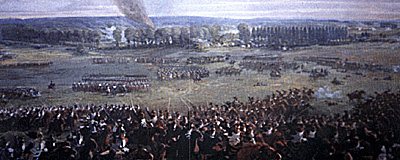 I have been fascinated by all aspects of the Napoleonic battlefield for more years than I care to remember. Until 1976, when John Keegan’s The Face of Battle was first published, like most other enthusiasts my comprehension of the process of battle was restricted to the “Military History” view of things. In which grand descriptive passages, told of sweeping maneuvers and glorious charges, without the merest hint of how these were achieved by the unfortunates involved in the process.
I have been fascinated by all aspects of the Napoleonic battlefield for more years than I care to remember. Until 1976, when John Keegan’s The Face of Battle was first published, like most other enthusiasts my comprehension of the process of battle was restricted to the “Military History” view of things. In which grand descriptive passages, told of sweeping maneuvers and glorious charges, without the merest hint of how these were achieved by the unfortunates involved in the process.
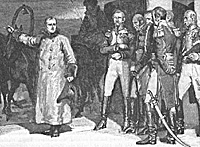 Did Napoleon have to concern himself with whether Murat would get his newly acquired Learjet to land safely in Paris? Was Nelson ever bothered by a need to examine the concentration required to pull off a deck landing at night? Had Wellington ever to consider the data analysis from three different battlefield information systems at the same time?
Did Napoleon have to concern himself with whether Murat would get his newly acquired Learjet to land safely in Paris? Was Nelson ever bothered by a need to examine the concentration required to pull off a deck landing at night? Had Wellington ever to consider the data analysis from three different battlefield information systems at the same time?
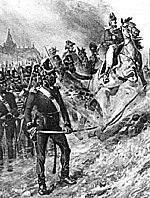 View of Situation
View of Situation
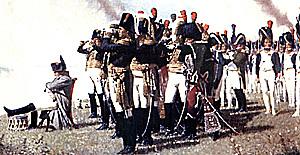 Expectations
Expectations
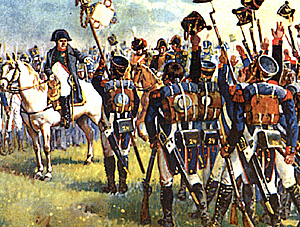 The correct measurement of information against expectation is a key element in SA. In the world of air safety, there are well documented instances, of aircrew failing to avoid accidents by either ignoring information that could have avoided a situation, or by continuing to trust instrumentation that their experience, or instinct, should have told them could not possibly be correct.
So it is with Battlefield perception.
The correct measurement of information against expectation is a key element in SA. In the world of air safety, there are well documented instances, of aircrew failing to avoid accidents by either ignoring information that could have avoided a situation, or by continuing to trust instrumentation that their experience, or instinct, should have told them could not possibly be correct.
So it is with Battlefield perception.
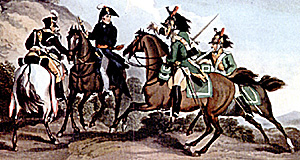 This could be attributed in several ways. Either in terms of the general having too large a command for his or his staff’s ability to cope with. Or, the demands of the mission being beyond their skill level or the force available to carry it out.
It can also be seen in terms of circumstances conspiring to present the commander with an overwhelming amount of information to process and decisions to make in to short a period of time.
This could be attributed in several ways. Either in terms of the general having too large a command for his or his staff’s ability to cope with. Or, the demands of the mission being beyond their skill level or the force available to carry it out.
It can also be seen in terms of circumstances conspiring to present the commander with an overwhelming amount of information to process and decisions to make in to short a period of time.
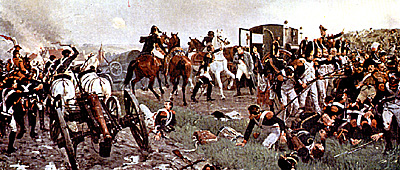 Well finally on safe ground here, I think! Dust, rain, hail, sleet, snow, smoke so thick people choked on it. You want degradation? We got degradation!
Well finally on safe ground here, I think! Dust, rain, hail, sleet, snow, smoke so thick people choked on it. You want degradation? We got degradation!